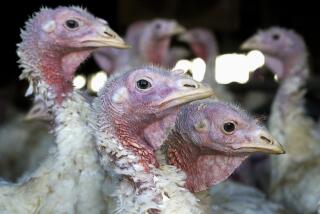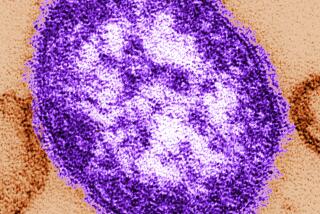Disneyland measles outbreak: Virus is identical to type found in Philippines
As California health officials search for the origins of the Disneyland measles outbreak, some of their detective work is pointing to the Philippines.
This measles virus shares the same genetic material as the type most commonly found in the Philippines, according to lab tests of the virus.
The highly contagious disease is a much larger problem in the Philippines, where more than 50,000 were sickened and 110 were killed in the last year.
Scientists said the findings make it likely that the virus originated in the Philippines. But they still don’t know exactly how it got into the United States and ultimately to Disneyland.
There is also a Philippines connection to at least two other measles outbreaks in 2014.
The return of an Amish humanitarian aid worker from the country caused an outbreak in Ohio that sickened more than 380 people. In California, state officials tied measles cases in early 2014 to unimmunized travelers returning from the Philippines.
The findings show how even one infected measles traveler from any country can cause a significant outbreak, especially at a time of declining vaccination levels in the United States.
California measles outbreak spreads to Canada
Officials emphasized that the outbreak could have come from a traveler from any number of countries, given that Disneyland draws visitors from around the world. In fact, the type of measles found in the Philippines, known as B3, has been present in at least 14 other countries, including Brazil, England and Germany as well as six other American states.
The California Department of Public Health reported its findings to federal authorities, based on a genetic analysis of the measles virus found in 30 California patients.
“The genotype is really the genetic fingerprint of the virus, and so it certainly tells us the number of cases that we have been seeing in California likely all relate to that individual that began at Disneyland,” said Dr. Matt Zahn, medical director of epidemiology for Orange County. Officials have not been able to identify the initial person or family that brought the measles into Disneyland.
The person or family who brought measles to Disneyland was linked to at least 39 people who worked or visited the theme park between Dec. 17 and Dec. 20.
In Orange County, none of the residents who were infected in the first wave had recently traveled overseas, showing that the outbreak was linked to a single event, rather than different outbreaks coming in from a number of different countries.
“It’s one more piece of evidence that what we’re seeing here is one individual outbreak, not several separate ones,” Zahn said.
B3 isn’t more virulent than others. Identifying the genetic fingerprint of the virus mainly helps officials track how the outbreak began and how it is spreading, Zahn said.
The most recent observations highlight how even people who never leave the country can still get measles. Simply going to places with large numbers of global travelers — such as theme parks, airports and other tourist destinations — can put unvaccinated people at risk, including infants younger than the age of 1 who are generally too young to be immunized.
Measles outbreak in California: What you need to know
Even before the Disneyland outbreak, six cases of measles since 2011 have occurred in California residents who went to large theme parks before they fell ill, according to state health officials.
And in January 2014, four measles cases were connected to airline passengers who went through the same domestic terminal gate during a four-hour period. All four were unvaccinated. Health officials did not disclose the international airport where the disease transmission occurred.
Most of the patients in the outbreak that began in Disneyland were unvaccinated. Of the 63 measles patients in California with vaccination records, 49 were completely unvaccinated. Twenty-eight were intentionally unvaccinated due to a parent’s personal beliefs, one was on an “alternative plan for vaccination,” and 12 were too young to be immunized, state officials said. Officials did not disclose other reasons patients were not vaccinated.
“This outbreak illustrates the continued importance of ensuring high measles vaccination coverage in the United States,” officials said.
The measles outbreak has since spread to seven other states, Mexico and Canada as tourists returned home. There have been at least 139 confirmed cases linked to the California outbreak.
About 1 in 5 have been hospitalized in California. Complications that result in hospitalization usually involve pneumonia and swelling of the brain.
Domestic transmission of measles was eliminated in the United States in 2000. For about a decade, the median number of measles cases reported annually was only 60, according to the U.S. Centers for Disease Control and Prevention.
But it’s still a problem in other parts of the world. There are an estimated 20 million cases of measles a year, and there were about 145,700 deaths due to the virus in 2013, CDC officials said.
And in 2014, global travel brought the measles back to the United States in large numbers. There were at least 644 measles cases, many linked to the outbreak in the Philippines. The World Health Organization said 25 American travelers who had visited the Philippines caught the measles. Most were not vaccinated.
“Measles can come into our country easily through visitors or when Americans travel abroad and bring it back,” said Dr. Anne Schuchat, director of the CDC’s National Center for Immunization and Respiratory Diseases.
More to Read
Sign up for Essential California
The most important California stories and recommendations in your inbox every morning.
You may occasionally receive promotional content from the Los Angeles Times.












